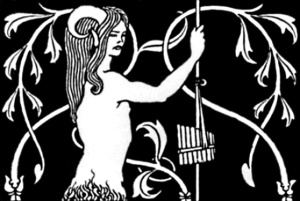 We are a sex positive tradition, but you must know the heart of the one you approach. No one must ever be approached with force or poor intent.
We are a sex positive tradition, but you must know the heart of the one you approach. No one must ever be approached with force or poor intent.
~ Victor Anderson, 2001
Coercion under any circumstances is morally and ethically wrong. When coercion appears in the sphere of teaching, however, there is a particularly invidious taint that enters the picture. Teaching is supposed to be a fostering–which often requires challenging the student; a process which has as its aim to provide a space in which the student can fully realize hir own potential to the finest possible flowering. In horticulture, gardeners employ techniques of training and “forcing” and other potentially harsh methods. But the human flower does not prosper under such conditions. Sri Krishna in the Bhagavad Gita says that to follow the path of Self Realization is to walk the razor’s edge; the path of the teacher can be one that requires, every bit as much,such rigorously disciplined definition. My happiest moments as a teacher have been seeing a student come fully and completely into the recognition of hir own Power; to fully own, and be at ease in, the wielding of hir own Strength, hir own faculty to pursue and embody Wisdom. Coercion can have no place in this. Tests are needed in the course of time to determine whether a student is ready to continue. Often, the result of such a test is that the teacher must withdraw for a period and allow time to pass and seeds to germinate. Such testing must not be exercised in a coercive manner. It should never be about the teacher’s supposed superiority over the student. It should always be about knowing just when the student is really ready to trod terrain that could otherwise be daunting, frightening, or overwhelming. Perhaps all of that is part of why one of my favorite teachers always described himself as a tourguide. A good guide knows not to lead one into the swamp until one is wearing proper wellies–so to speak.
Witchcraft is a deeply physical discipline. The Faery current is fierce, feral, and unabashedly sexual. It also holds high the values of honor, respect, and what Victor Anderson called “impeccability.” Cora Anderson wrote: The Craft as we know it has a code of honor and sexual morality that is as tough and demanding as the Bushido of Japan and of Shinto, which it strongly resembles and in many important ways is identical to. This code is in no way puritanical, ascetic or anti-sexual. When I teach the Craft, I bear this code of honor rigorously in mind. And all of this is why, when I evaluate a potential student, I look for an individual who has a secure, well-established sense of hir own boundaries and the capacity to learn and maintain habits of good psychic hygiene. If the individual seems too unsteady, unsure of hirself, or just unstable, I will advise hir to go home and work on personal growth and nurture. In such cases, I think it is most inadvisable for a person to engage in Magickal work that has any goal beyond self-healing and self-care. And again, this is why I always begin by teaching the work of grounding, clearing, and centering: observing a person going through these exercises and checking in with hir immediately afterwards can tell one a great deal about what’s really going on inside, as opposed to the “public version”–how the individual presents hirself to the outside world.
I will undoubtedly have future remarks to make regarding sex, sexuality, and the Craft, but the foundational principle must be made clear: teaching and coercion, on any level, don’t go together.

Pingback: Consent, Coercion, and Teaching the Craft (by Shimmer) | Anderson Faery (Feri) Witchcraft
Yes, yes, and yes! I love this, and I love the revision on AndersonFaery. Well said indeed!
LikeLike